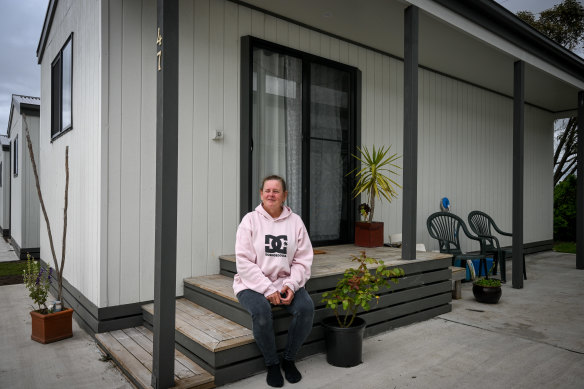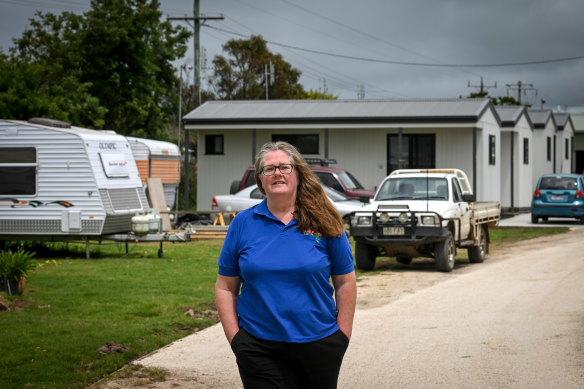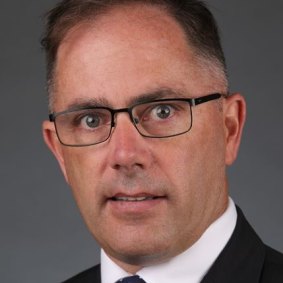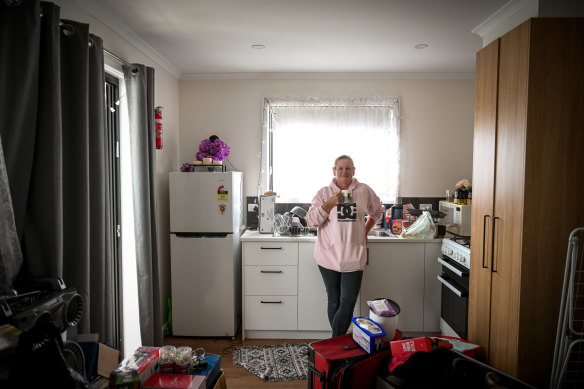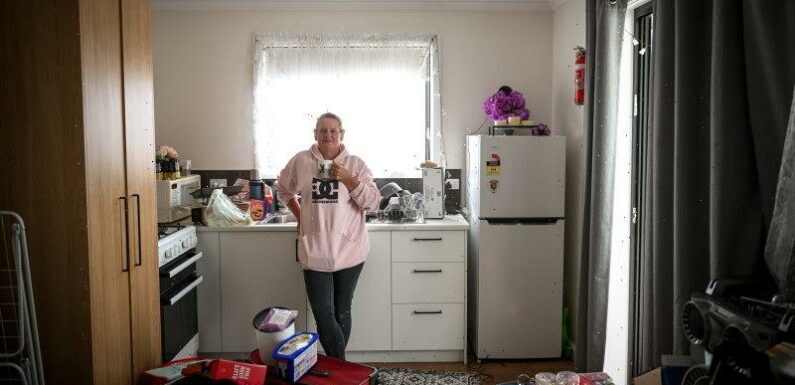
Australia’s country towns are experiencing rising homelessness as rents skyrocket, vacancy rates plummet and people on low incomes find themselves unable to afford a home.
The 2022 Australian Homelessness Monitor reveals a rapid growth in homelessness in regional Australia over the past four years.
Kerrie Hogan has been living at the Colac Caravan Park for the past two years.Credit:Eddie Jim
The most dramatic example was in regional Western Australia, where homelessness rose by 35 per cent in the four years to 2021-22, followed by a 29 per cent spike in regional Queensland.
In regional Victoria, the average monthly number of people using homelessness services in 2021-22 was 9949, up 6 per cent from 2017-18.
The monitor found housing affordability stress was the fastest growing cause of homelessness across the country, with the average monthly total of people seeking help for this reason increasing by 27 per cent.
In regional Victoria alone, the proportion of private tenancies affordable for low-income households plummeted from 58 per cent in 2017 to 24 per cent in 2022.
The monitor – commissioned by Launch Housing and conducted by researchers from the University of Queensland and the University of NSW – is the first major homelessness analysis spanning the COVID-19 years.
Last year the Colac Herald revealed that Colac Otway Shire, in the south-west of Victoria, was the local government area with the highest rate of homelessness in the state, according to Department of Health and Human Services data.
The rural shire, which has a population of about 21,000, has high rates of disadvantage and family violence.
The owner of Colac Otway Caravan and Cabin Park, Viola Ganim, has two caravans she offers for emergency accommodation for people facing homelessness. Another eight house permanent residents.
Ganim said she had never seen such demand from people searching for a place to live in the 10 years she has run the park.
“I get calls every day for long-term accommodation,” she said.
Ganim said more people are looking to rent or buy in Colac and the many industries that operated there were constantly seeking to attract more workers, which put more strain on the local housing market.
In June, the Colac Herald reported the median weekly rent had jumped from $320 in June 2021 to $380 – nearly 20 per cent in 12 months.
Viola Ganim has set aside two caravans for emergency accommodation for the homeless at her Colac caravan park.Credit:Eddie Jim
Thirty per cent of Colac Otway Shire’s households experience rental stress (where more than 30 per cent of the household’s income is spent on rent), according to the Barwon South West Homelessness Network.
“It’s the worst I’ve seen for affordability,” Ganim said. “The prices are astronomical for a country town.”
In 2020-21 there were 551 households in the shire that received support from homelessness agencies.
Liberal MP for Polwarth Richard Riordan.
Polwarth MP Richard Riordan, who has lived all his life in Colac, said homelessness was always something that happened in the “big smoke”.
But in recent years he became aware of older women sleeping in their cars outside the police station.
“I am embarrassed that in a country town with blocks of land and availability, we have had people forced to sleep in their car in front of the police station, walk around the corner of the hospital and use the public facilities there for showering,” he told a recent housing forum.
When Kerrie Hogan moved to Colac two years ago, she was desperate for a place to live so took the only option available at the time – a cabin at the caravan park with its own toilet but no shower or hot water.
Hogan had moved from Queensland after a relationship broke down, to help care for her late mother, who had cancer.
A caravan park was the only option for Kerrie Hogan when she moved to Colac two years ago.Credit:Eddie Jim
Now she has upgraded to a self-contained cabin with a kitchenette and full bathroom.
Hogan is a casual disability support worker and hopes eventually to buy her own home when she starts working full-time, but said it was becoming increasingly expensive to rent let alone buy houses in Colac.
“There’s not that many houses available,” she said. The vacancy rate for private rentals in Colac was a wafer-thin 0.6 per cent in October, according to SQM Research.
“I’m better off staying where I am at the moment,” Hogan said.
In a submission to the state government, the Barwon South West Homelessness Network said private companies were buying houses or taking out leases to house workers.
As a result, it said, there were fewer emergency accommodation options in rural and regional areas.
Major events and demand for holiday accommodation over the summer have a similar effect.
“In Geelong, each time the Geelong Football Club plays at home, a regatta takes place on the Barwon River or a tourism event [takes place, and] there is no emergency accommodation available,” the network’s submission said.
The Homelessness Monitor found that in the two years to June 2022, regional rent increases tended to outpace rising rents in capital cities across Australia.
Lead author Professor Hal Pawson said that during the pandemic, house prices and rents had risen steeply in regions that had become attractive to tree changers, who suddenly had the flexibility to work from home. “Homelessness numbers are to some extent a result of that,” he said.
The monitor found the rental property vacancy rate for non-metropolitan Australia was running at an “extraordinarily low” 0.6 to 0.7 per cent through 2021-22.
“As a stark indication of the rental affordability crisis for the lowest income Australians, among the 46,000 private rental properties advertised for let across Australia in March 2022, just 1.4 per cent were affordable to an age pensioner couple,” it said.
The monitor found that across Australia the average monthly number of people using homelessness services was 91,300, an increase of 8 per cent over four years.
The sudden reduction in street homelessness achieved through 2020 through COVID-19 emergency accommodation in Melbourne, Sydney and Brisbane provided only temporary respite to the problem.
Launch Housing chief executive Bevan Warner said the growth in housing affordability as a driver of homelessness reflected what he was seeing on the ground.
“In the last 12 months Launch Housing saw a 29 per cent increase in people seeking assistance with their rental and bond payments,” he said.
The Victorian government said the Big Housing Build program would guarantee at least $1.25 billion of investment in the regions, and minimum investment guarantees across 18 areas including Ballarat, Bendigo, the Latrobe Valley and Geelong.
“We’re already hard at work on our plans for the Commonwealth Games villages, with social and affordable housing to be part of our plans for the Games’ legacy after the event, a spokesperson said.
The Morning Edition newsletter is our guide to the day’s most important and interesting stories, analysis and insights. Sign up here.
Most Viewed in National
From our partners
Source: Read Full Article
